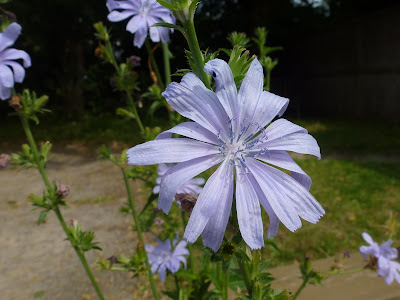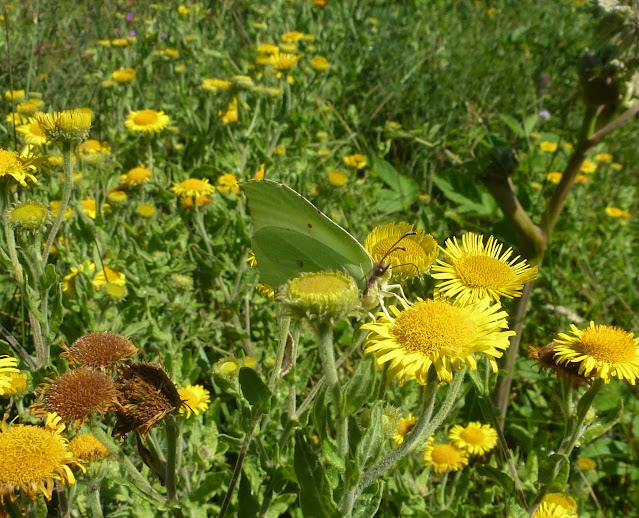A curiosity of today’s visit to NWT’s Hickling Broad and Marshes nature reserve was that two of the most interesting sightings were in the long grass in the open picnic area by the visitor centre. The first of these was the day-flying moth latticed heath. Rachel in the visitor centre checked it out and it’s not the first for the reserve, but far from an everyday species. (More information on Norfolk Moths.) For the second good find, scroll down to lunchtime!
 |
| Latticed heath moth. |
A
chiffchaff called and briefly showed, and an early find was a green cigar gall.
We get used to seeing these in winter once the reeds they are on have turned
brown; perhaps it’s just a question of getting your eye in. There was a great white
egret and a little egret from the first hide (Cadbury Hide), and a distant
great spotted woodpecker high on a dead tree. Bramble leaves on this part of
the reserve were noticeably affected by a rust fungus.
Cigar gall; abundant rust fungus on bramble.
On Hickling Broad there was a flock of coots, a few great crested grebes, mute swans, herons, distant gulls and a common tern. By where the boat tours leave, a common lizard soaked up some warmth on wooden fence plank.
The next stretch was under oaks, prompting a look for galls, now coming into their peak season. On the oaks were spangle galls, cherry galls and knopper galls on acorns or fallen on the ground, all three types of gall induced by gall wasps. Farther on we found thistle galls on creeping thistle, caused by a mite, and a robin’s pin cushion on a dog rose, caused by a gall wasp.
 |
| Oak galls collage. Left, knopper galls. Top right, spangle galls. Bottom right, cherry galls (the cherry colour comes later). |
 |
| Dingy footman. Also the brown lumps above the moth are probably another oak gall, 'collared bud' galls from yet another gall wasp, Andricus curvator. |
The star birds of Hickling – like harriers, bitterns and cranes – were generally conspicuous by their absence from view, though we did hear bearded tits. At Bittern Hide, the best birds were inside: three swallows in a nest.
At Brendan’s Marsh a wader flew up the channel and landed by the flock of Canada geese: a common sandpiper. Then we saw a closer wader in a pool in the mare’s tail, this one a green sandpiper. There were great white and little egrets, though no sign of the spoonbills recently announced to have bred here. Much of the open ground was bright yellow, a covering of buttonweed or Cotula. It was lunchtime, so we took the woodland route back to the visitor centre, finding a willow emerald damselfly on route.
Time for picnic lunches. The waste bins were taped and labelled as out of use, the reason being a steady stream of hornets through a gap in the cupboard that houses the bins. (The nest was therefore out of sight, though here is photo of it on Mike Dawson’s Facebook.)
 |
| Wasp spider, a first for Hickling (Helen Crowder). |
It was where we’d seen the latticed heath that Helen made the best discovery. Two weeks ago, at Thompson Common, it was Ann who’d found the wasp spider. Today it was Helen’s turn to discover one. The female wasp spider was in a typical position, in long grass likely to have plenty of cricket & grasshopper prey. They can be quite static, though this wasp spider’s web was incomplete, so she was often on the move, adding strands. Eventually Rachel was free from her meet-and-greet duties and came to enjoy the discovery. Later she advised that it was a first record for the reserve … and a good reason to keep the grass here uncut.
 |
| More spiders in the Hickling picnic area (Helen Crowder). Probable ID is candy-striped spider Enoplognatha ovata. |
Many of the group extended our stay into the afternoon, albeit dropping from seven to four as we walked past Brendan’s Marsh and onto Stubb Mill. Brendan’s Marsh had more wildfowl species than you might expect in high summer: mallards and gadwalls, of course, also teals, shovelers and two wigeons. A little ringed plover flew in to land near another green sandpiper and there was a large flock of lapwings. We remarked on how great white egrets are impressive when they fly: three here this afternoon, plus little egrets, both now routine sightings at Hickling.
By
the path, two blue-tailed damselflies floated around, and one settled for long
enough to allow photos. A reed warbler sang briefly – more of sub-song, really.
At the far end of Brendan’s Marsh we scanned an open area and found a Chinese water
deer looking at us.Blue-tailed damselfly (Helen Crowder).
No surprise that on a warm summer’s day there were plenty of butterflies around. Red admirals were in good numbers: these included six on a patch of hemp agrimony during the morning. Other included speckled woods, gatekeepers, green-veined and small whites, and a peacock soaking up warmth in a hollow in a broken tree trunk.
.JPG) |
| Peacock butterfly. |
.JPG) | ||
Mating small whites at the Stubb Mill viewpoint, with Heigham Holmes in the background.
|
Chris
Durdin












